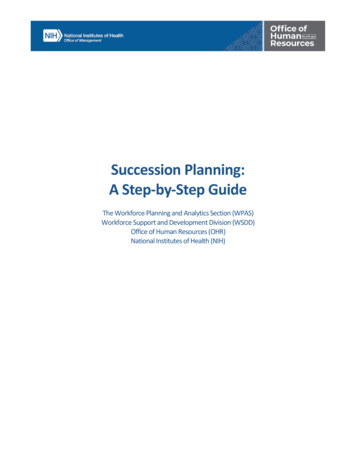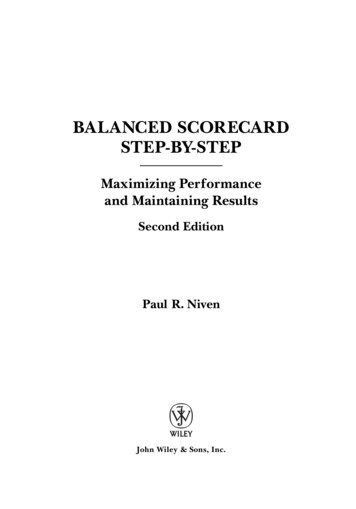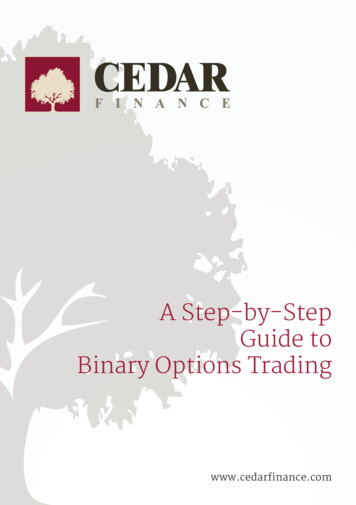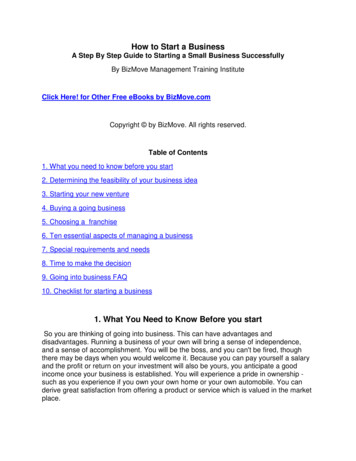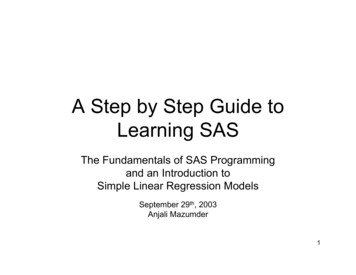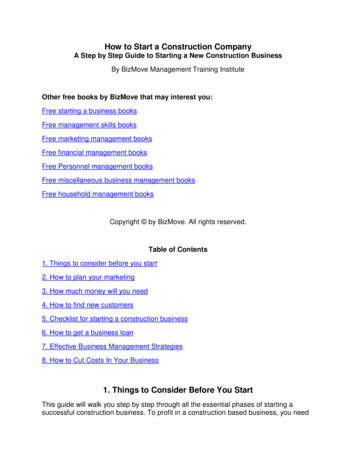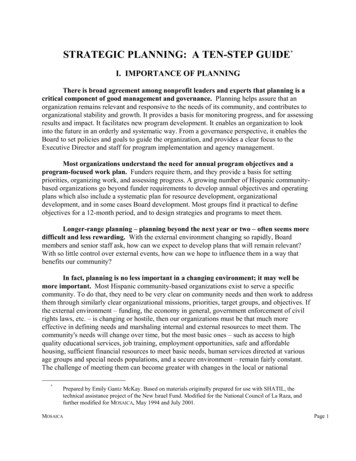
Transcription
STRATEGIC PLANNING: A TEN-STEP GUIDE*I. IMPORTANCE OF PLANNINGThere is broad agreement among nonprofit leaders and experts that planning is acritical component of good management and governance. Planning helps assure that anorganization remains relevant and responsive to the needs of its community, and contributes toorganizational stability and growth. It provides a basis for monitoring progress, and for assessingresults and impact. It facilitates new program development. It enables an organization to lookinto the future in an orderly and systematic way. From a governance perspective, it enables theBoard to set policies and goals to guide the organization, and provides a clear focus to theExecutive Director and staff for program implementation and agency management.Most organizations understand the need for annual program objectives and aprogram-focused work plan. Funders require them, and they provide a basis for settingpriorities, organizing work, and assessing progress. A growing number of Hispanic communitybased organizations go beyond funder requirements to develop annual objectives and operatingplans which also include a systematic plan for resource development, organizationaldevelopment, and in some cases Board development. Most groups find it practical to defineobjectives for a 12-month period, and to design strategies and programs to meet them.Longer-range planning – planning beyond the next year or two – often seems moredifficult and less rewarding. With the external environment changing so rapidly, Boardmembers and senior staff ask, how can we expect to develop plans that will remain relevant?With so little control over external events, how can we hope to influence them in a way thatbenefits our community?In fact, planning is no less important in a changing environment; it may well bemore important. Most Hispanic community-based organizations exist to serve a specificcommunity. To do that, they need to be very clear on community needs and then work to addressthem through similarly clear organizational missions, priorities, target groups, and objectives. Ifthe external environment – funding, the economy in general, government enforcement of civilrights laws, etc. – is changing or hostile, then our organizations must be that much moreeffective in defining needs and marshaling internal and external resources to meet them. Thecommunity's needs will change over time, but the most basic ones – such as access to highquality educational services, job training, employment opportunities, safe and affordablehousing, sufficient financial resources to meet basic needs, human services directed at variousage groups and special needs populations, and a secure environment – remain fairly constant.The challenge of meeting them can become greater with changes in the local or national*Prepared by Emily Gantz McKay. Based on materials originally prepared for use with SHATIL, thetechnical assistance project of the New Israel Fund. Modified for the National Council of La Raza, andfurther modified for MOSAICA, May 1994 and July 2001.MOSAICAPage 1
environment, such as a poor economy or a hostile or unresponsive government, however; and itis here that strategic or long-range planning can be most helpful. Planning is designed to help anorganization define its vision for the future and then determine systematically how it will getthere, understanding obstacles and figuring out ways to overcome them.There is an important caveat: Longer-range planning requires some level oforganizational stability. It is very difficult to plan in a crisis, and unrealistic to look five yearsahead unless an organization has some confidence that it will exist next year, and that most of itskey staff and its Board leadership will continue to be affiliated with the organization. Board andstaff also need the time to plan, which means that they must not be using every minute to carryout functions required for survival. Moreover, while planning provides increased organizationaldefinition, a sound base for planning is consensus concerning a well-defined mission statementand/or organizational goals – these must often be developed as a foundation for longer-termplanning. It is also difficult to plan if the organization is so young or its leadership so new thatthey do not have a good sense of the community and of the broader external environment. Mostnew organizations, or groups which have undergone major institutional difficulties or change,find that they do best by first attempting to reach consensus on an organizational missionstatement and then doing shorter-range planning, usually for a single year. Learning from thatexperience, they can begin a longer-term planning process.Planning that focuses on a period of three years or more requires an organized,serious effort which takes time and energy. There may need to be a formal community needsassessment as input to planning. This is extremely valuable, but also demanding. Moreover,planning is not a one-time effort; any plan needs to be reviewed, monitored, and updated. Thebenefits to an organization can be significant -- a clear focus, a sense of joint purpose andagreed-upon priorities, consensus on strategies, and a basis for measuring progress and impact.II. DEFINING LONG-RANGE AND STRATEGIC PLANNINGThe term strategic planning has become very popular in recent years. Many nonprofitorganizations now talk about doing strategic planning rather than long-range planning. Yet thedifference between the two is not intuitively obvious, nor universally agreed upon. Following aretypical definitions and explanations of the two terms:Long-range planning: The process by which the leaders of an organization determinewhat the organization wants to look like at the end of a specified period of time – usually three tofive years – then use that vision to establish multi-year goals and objectives which describe whatthe organization wishes to accomplish, and develop programs, tasks, and timelines for achievingthem. Long-range planning predicts future conditions and realities, internal and external, andplans how the organization can function effectively within them. Because it involves multi-yearprojections, it cannot be as specific as short-term or operational planning, which generates awork plan with detailed annual objectives, tasks, methods, timelines, and responsibilities.However, it tends to be more focused on specific objectives and timelines than strategicplanning.MOSAICAPage 2
Strategic planning: The process by which leaders of an organization determine what itintends to be in the future and how it will get there. To put it another way, they develop a visionfor the organization's future and determine the necessary priorities, procedures, and operations(strategies) to achieve that vision. Included are measurable goals which are realistic andattainable, but also challenging; emphasis is on long-term goals and strategies, rather than shortterm (such as annual) objectives. Strategic planning assumes that certain aspects of the futurecan be created or influenced by the organization. Strategic planning is ongoing; it is "the processof self-examination, the confrontation of difficult choices, and the establishment of priorities"(Pfeiffer et al., Understanding Applied Strategic Planning: A Manager's Guide). Strategicplanning involves "charting a course that you believe is wise, then adjusting that course as yougain more information and experience" (Wilder Foundation, Strategic Planning Workbook).Differences between strategic and long-range planning: While closely related tolong-range planning, strategic planning is generally considered to place a greater emphasis onstrategies – on how the organization will achieve its vision – while long-range planning placesgreater emphasis on determining the vision.III. A STRATEGIC PLANNING PROCESSThere are many different models and action steps for strategic planning. One approach issummarized below. It assumes a cooperative effort between Board and staff, perhaps with aspecial strategic planning committee of Board members and staff taking responsibility for theeffort. Some of the work can be done in committee, while Board and staff planning sessions orretreats are also likely to be required, both early and late in the planning process. Typical stepsare described below, along with some suggested approaches for carrying out each step.Frequently, Steps 1-3 occur before a strategic planning retreat, Steps 4-7 during the retreat, andSteps 8-10 after the retreat.1.Agree on a strategic planning process. This may be done at a Board meeting with keystaff present, or may require a special meeting or retreat, including Board, key staff, andsome external stakeholders. At the session:Provide an understanding of what strategic planning is and how it is done;Discuss its potential value to the organization, in terms of providing a common visionand focus, with agreed-upon goals and strategies;Consider the costs of doing strategic planning, in terms of staff and Board time andother resources – and what might need to be given up in order to develop a plan; ifthe organization is in crisis or is financially or organizationally unstable, it may bedifficult or unwise to enter into a strategic planning process until the immediateproblems and needs have been successfully addressed;MOSAICAPage 3
Consider whether the organization is "ready" for a long-range plan or whether it maybest focus on a short-term plan, perhaps doing a one-year plan and then undertakinglonger-term planning at the end of that year;If strategic planning seems appropriate, consider what procedures or steps can beused to establish and implement a strategic plan;Agree upon a process and establish responsibilities for the various steps in theprocess, including at least one day (or several half-days or evenings) devoted to aBoard and (all or senior) staff planning retreat or a series of planning meetings.Except for a very small organization, it will probably be desirable to set up a strategicplanning committee or task force. Choose participants carefully, assuring theircommitment to the process and their willingness to devote significant time to theplanning effort. Usually the coordinating group will include a mix of Board leaders andmembers, as well as senior and middle managers. Some groups also include arepresentative of technical and/or support staff. Representatives of stakeholders –funders, sister organizations, and allies – and perhaps former leaders of the organizationor other resource people might also be included. The organization may also want toinclude an outside facilitator or consultant who will assist with the process and withpreparation of the strategic planning document – or this may be done by staff.Be sure to allocate sufficient staff time to the strategic planning process. It may benecessary to reduce the regular workloads or responsibilities of staff and Board memberswho are expected to play a key role in developing the strategic plan.2.Carry out an environmental scan. This helps provide an understanding of how theorganization relates to its external environment. The scan usually includes an externalcomponent -- identifying and assessing opportunities and threats in the externalenvironment -- and an internal component -- assessing organizational strengths andweaknesses. This process is often referred to as "SWOT": strengths, weaknesses,opportunities, and threats. The external component of the environmental scan should include areview of the target or service community and the broader environmentin which the organization operates, to identify the opportunities andthreats facing the organization. This might include the following:Consider forces and trends in the broader community, political,economic, social, and sometimes technological (See Bryson,Strategic Planning for Public and Nonprofit Organizations). Lookat changing demographics, political trends, community values,economic trends, the implications of new or changing laws andregulations affecting the organization, communications and othertechnological trends -- and consider their impact on yourorganization and the population it serves.MOSAICAPage 4
Look carefully at the immediate target community or service areato determine its status and needs, and specifically those of currentand potential clients and beneficiaries of the organization's servicesand advocacy.Consider opportunities and challenges related to resources andfunders.Look at actual and potential collaborators and competitors,including organizations which may serve the same neighborhoodand/or target population or may seek funds from the same fundingsources, public or private.This process may involve something as extensive as a community needsassessment with interviews, focus groups, and fax or e-mail surveys that isconducted by a consultant, or may be limited to a small number of informaldiscussions with clients and other community residents, heads of other Hispanicand non-Hispanic organizations, public officials, funder representatives, and otherappropriate individuals. The internal component of the environmental scan includes anassessment of the organization's strengths and weaknesses. This mayinclude a number of components or approaches.You may want to assess current organizational performance in termsof financial and human resources (inputs), operating methods orstrategies (processes), and results or outcomes (outputs). If theorganization does not have extensive objective measures of itsoutcomes, perceived performance can be partially determined throughasking clients and stakeholders. Try to understand how key players orstakeholders in the broader community -- as well as constituents orclients -- view the organization. Sometimes, brief written forms aresent to, or interviews conducted with, key stakeholders; interviews arebest conducted by a consultant, to assure frank and honest responses.Once you have this i
used to establish and implement a strategic plan; Agree upon a process and establish responsibilities for the various steps in the process, including at least one day (or several half-days or evenings) devoted to a Board and (all or senior) staff planning retreat or a series of planning meetings. Except for a very small organization, it will probably be desirable to set up a strategic planning .

